mobile View, to the German Version tap the flag


- Republic of Nicaragua
- presidial republic
- own name: República de Nicaragua
• Flags
• Historical Flags
• Meaning/Origin of the Flag
• Coat of Arms
• Meaning/Origin of the Coat of Arms
• Aircraft Roundel
• Map
• Numbers and Facts
• History
• Origin of the Country's Name
– Mosquito Coast
– Corn Islands
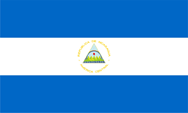
national, state, merchant and naval flag,
ratio = 3:5,
Source, by: Flags of the World





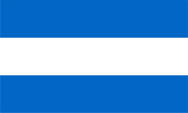
unofficial variant,
National flag,
ratio = 3:5,
Source, by: Flags of the World




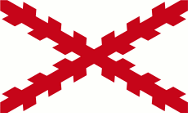
1535–1785,
to the Spanish Vice–Kingdom of New Spain,
Source, by: Wikipedia (EN)



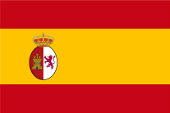
1785–1821,
to the Spanish Vice–Kingdom of New Spain,
Source, by: Wikipedia (EN)



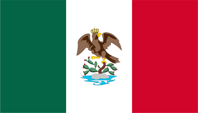
1821–1823,
Nicaragua belongs to Mexico,
Flag of Mexico,
Source, by: Wikipedia (ES)



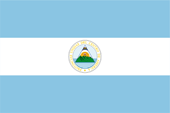
1823–1824,
National flag of the United Provinces of Central Amerika,
ratio = 2:3,
Source, by: Wikipedia (D)



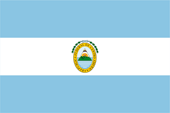
1824–1839,
National flag of the Central American Confederation,
ratio = 2:3,
Source, by: Wikipedia (D)



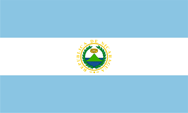
1839–1854,
National flag,
ratio = 3:5,
Source, by: Flaggen und Coat of arms of the Welt



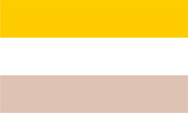
1854–1858,
National flag,
ratio = 3:5,
Source, by: Wikipedia (ES)



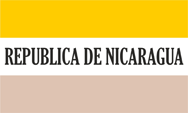
1854–1858,
Merchant flag,
ratio = 3:5,
Source, by: Wikipedia (ES)



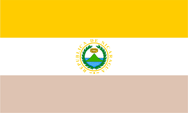
1854–1858,
State flag,
ratio = 3:5,
Source, by: Wikipedia (ES)




1858–1889,
national, state, merchant and naval flag,
ratio = 3:5,
Source, by: Wikipedia (ES)



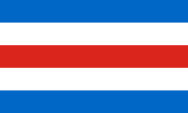
1889–1893,
national, state, merchant and naval flag,
ratio = 3:5,
Source, by: Wikipedia (ES)




1893–1896,
national, state, merchant and naval flag,
ratio = 3:5,
Source, by: Wikipedia (ES)



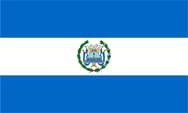
1896–1908,
national, state, merchant and naval flag,
ratio = 3:5,
Source, by: Wikipedia (ES)



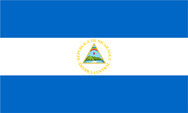
1908–1971,
national, state, merchant and naval flag,
ratio = 3:5,
Source, by: Wikipedia (ES)




The today's flag of Nicaragua was officially hoisted on 4th of September in 1908, and confirmed on 27th of August in 1971. The flag corresponds to the flag of the Centalamerican Federation, but the stripes show an other blue. This blue has not been precisely defined to this day; the corresponding regulation only speaks of "cobalt blue". The flag history of Nicaragua otherwise seems somewhat confused, as there are very different accounts of it. Nicaragua was initially a member of the Central American Federation and flew its flag. The flag of the Centalamerican Federation is a blue-white-blue horizontal striped flag with a coat of arms in the middle of the white stripe. It is a design from Manuel José Arce and was created in context with the anti-Mexican defence struggle, and hoisted up for the first time in 1822 and goes back to the flag of the United Provinces of Río de la Plata, today's Argentina. This flag was adoped for the United Provinces of Central Amerika (Cental American Confederation) on 21st of August in 1823. The colours blue-white-blue (Cental American colours) were pristine used in the struggles for independence against Spain and they are a symbol of solidarity with other South American states, and embody the common will of the members of federation for freedom and independence. The blue stripes stand for justice, loyalty, brotherhood, strength, courage, sky, for the Caribbean Sea and the Pacific Ocean. Today they also stand for the lakes of Xolotlán and Cocibolca. The arrangement of the colours describes the position of Cental America between the both oceans. The shade of the blue is disputed, some sources give a dark blue, others a light blue. The coat of arms – just as the flag – was introduced on 21st of August in 1823. It shows five volcanos, standing for the members of the federation. The triangle symbolizes equality, the phrygian cap symbolizes freedom, and the rainbow symbolizes hope. On 22nd of November in 1824 the United Provinces were renamed in "Federal Republic of Central America" and it was introduced a flag with an in only some details changed coat of arms. It was used only until the 1st of January in 1825, in the time after the entities used their own flags, except El Salvador and Honduras. In the period from the independence of the Central American Confederation from Mexico (1823) nearly to the end of the 19th century, whole Central America was characterized by enduring wars, civil wars and continual changes of power, so that the flag history in some countries of Central America can be very confused. Even during the membership in the Central American Federation, the coat of arms of the confederation was removed from the flag and in this way created the first flag of Nicaragua which was maintained until 1854. In the year 1854 was intoduced a new flag with a new coat of arms. The triangular shield showed from now on only one volcano and was surrounded by weapons, flags and oak and laurel leafs. The flag showed now three horizontal stripes in the colours yellow, white and "Nacar" (Pearlescent). This flag was only used until 1858. After that, Nicaragua reverted to the flag with the three horizontal stripes in blue, white and blue, sometimes showing the respective at that point of time used coat of arms in the middle of the white stripe or not. Only between 1889 and 1893 did the flag allegedly consist of five horizontal stripes, with a red stripe added in the middle.
Source:
Wikipedia (ES),
Flaggen und Coat of arms of the Welt,
Flags of the World

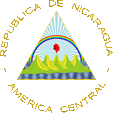
since 1971,
Coat of arms of Nicaragua,
Source: Wikipedia (ES), C records,
Attribution, via Wikimedia Commons
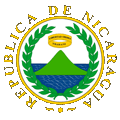
1854–1880,
Coat of arms of Nicaragua,
Source: Wikipedia (ES), Fornax,
Public domain, via Wikimedia Commons
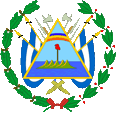
1880–1908,
Coat of arms of Nicaragua,
Source: Wikipedia (ES), Flag of Nicaragua (1896–1908),
CC BY-SA 3.0, via Wikimedia Commons
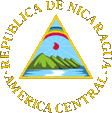
1908–1971,
Coat of arms of Nicaragua,
Source: Wikipedia (ES), Caleb Moore,
Public domain, via Wikimedia Commons

The coat of arms of Nicaragua corresponds nearly exact to the on the 21st of August in 1823 introduced volcano scutcheon of the Centalamerican Federation. The only difference consists in the wording around the the coat of arms. The coat of arms, just as the flag, was introduced on 21st of August in 1823. It shows five volcanos, standing for the members of the federation. The triangle symbolizes equality, the phrygian cap symbolizes freedom, and the rainbow symbolizes hope. Between 1854 and 1880, the coat of arms showed only one volcano with a hoop crown above it, and it was additionally surrounded by arms, flags and oak and laurel leaves between 1895 and 1908.
Source:
Wikipedia (ES),
Die Welt der Flaggen

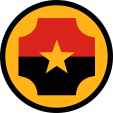
since 1979,
Aircraft Roundel,
Source, by: Wikipedia (EN)
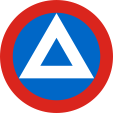
1962–1979
Aircraft Roundel,
Source, by: Wikipedia (EN)

Location:
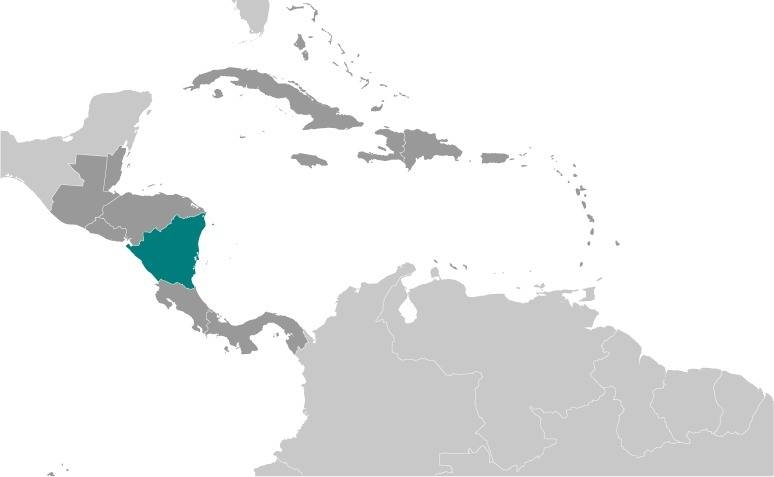
Source: CIA World Factbook
Map of the country:
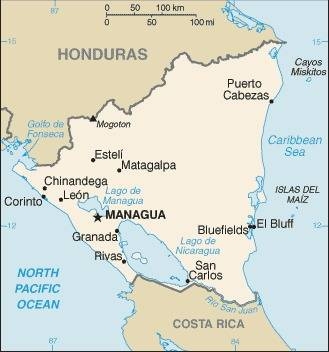
Source: CIA World Factbook
Clickable Map of Nicaragua:
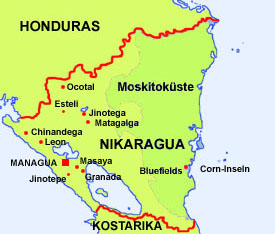
Source: Volker Preuß

Area: 46.430 square miles
Inhabitants: 6.600.000 (2020), thereof 70% Mestizos, 18% Europeans, 9% Blacks/Mulattos, 3% native Indians, Arabs, Chinese and even ca. 1.000 Germans
Religions: 55% Roman Catholic, 27% Protestant, 14% Non-Religious
Density of Population: 142 inh./sq.mi.
Capital: Managua, 1.033.622 inh. (2016)
official Language: Spanish
other Languages: Miskito (Indio language), English (at the Mosquito Coast)
Currency: 1 Córdoba Oro (NIO, C, NC) = 100 Centavos
Time Zone: GMT – 6 h
Source: Wikipedia (D), www.auswaertiges-amt.de

1502 · Columbus discovers the eastern coast of Nicaragua (Mosquito Coast)
1523 · beginning of the Spanish capture and colonization by Hernández de Córdoba and Gonzales de Avila, murder of big parts of the native Indian population
1535 · establishment of the Vice Kingdom of New Spain, which Central America (and therewith even the today's Nicaragua) gets affiliated as "General Capitanate of Guatemala"
1630 · first British settlement on the Mosquito Coast
1655 · the Mosquito Indians subordinate themselves the British protection for perpetuation of their independence against Spain
1821 · Nicaragua declares its independence
1821 · Nicaragua joines the Empire of Mexico
1823 · after the overthrow of the Mexican emperor gets the connexion to Mexico untied, and the states of the former General Capitanate of Guatemala combine to the "United Provinces of Central America" (Central American Confederation)
1839 · Nicaragua leaves the Central American Confederation, armed conflicts between Conservatives and Liberals
1855 · the US-American adventurer and pirate William Walker invades with his little army – the "Falange americana de los inmortales" (American Combat Troop of the Immortals) – in behalf of the bankers Morgan and Garrison and of the railroad magnate Vanderbilt in Nicaragua to stop the for many years persisting civil war between Conservatives and Liberals, he helps the conservative Panciano Corral to take the position of the president
12th of December 1856 · William Walker proclaims hisself to the president after he executed Panciano Corral because of betrayal and establishes a terror rule
1857 · William Walker becomes banished by rebellious natives and escapes to the USA
28.01.1860 · Treaty of Managua, United Kingdom transfers the Protectorate of the Mosquito Coast to Nicaragua
20.11.1894 · the Mosquito Coast is annexed by Nicaragua
1895–1898 · Nicaragua constitutes together with Honduras and El Salvador the Great Republic of Central America
1912 · US-American military intervention
1914 · the Corn Islands become leased from USA for 99 years from Nicaragua in 1914 and were developed as navy and air force base
1927 · Anti-American revolt under leadership of Augusto César Sandino
1932/33 · withdrawal of the US troops
21st of February 1934 · assassination of Augusto César Sandino by order of Anastasio Somoza García – the chief of the National Guard – in Managua
1936 · military coup d'état of the National Guard under Anastasio Somoza García
1937–1947 · first dictatorship of the General Anastasio Somoza García
1950–1956 · second dictatorship of the General Anastasio Somoza García
1956 · assassination of General Anastasio Somoza García
1961 · foundation of the FSLN (Frente Sandinista de Liberación Nacional)
1971 · the USA terminate the leasing treaty over the Corn Islands earlier and left in 1971 the islands
1967–1979 · dictatorship of Anastasio Somoza Debayle, son of the Anastasio Somoza García
1978 · rebellion of the people under leadership of the FSLN, suppression by the armed forces
1979 · once more rebellion of the people under leadership of the FSLN, overthrow of the government on the 19th of July in 1979, escape of the Somoza family to Paraguay, establishment of a provisional government in the framework of a coalition
1980–1984 · the FSLN pushes aside its partners in the coalition, gaining military activities of so named "Contras"
4th of November 1984 · elections, the FSLN gains two third of the votes, Daniel Ortega – the chief of the FSLN – becomes president
1985 · economical embargo of the USA
1987 · Nicaragua grants the Mosquito Coast a limited autonomy again
1990 · elections, victory and takeover of government by the civil alliance, the "Contras" lay down their arms, the USA terminate the economical embargo
2018 · riots
Source:
Atlas zur Geschichte,
World Statesmen,
Wikipedia (D)

The name "Nicaragua" has its roots in the name of a chief of the indians from the Chibcha nation. His name was "Nicarao", and even his tribe used that name.
Source:
Handbuch der geographischen Namen


![]()































